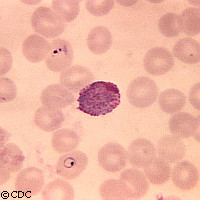New weakness found in malaria
European researchers have long set their sights on tackling malaria, a potentially deadly disease whose spread has not been as yet stopped in developing countries. Now, new research has brought to light one of the tricks the disease uses to camouflage itself from our immune system. This trick was exposed by research conducted by Matthew Higgins of the Department of Biochemistry at the University of Cambridge in the UK. His results have been published in the Journal of Biological Chemistry. Malaria is perhaps one of the most deadly parasitic diseases, and according to some researchers, it is responsible for the deaths of two million people a year. In a number of developing countries where it is most prevalent, some people have developed partial immunity to malaria after suffering multiple episodes of the disease. Unfortunately for them, this partial immunity is no protection. Instead, the disease is able to mimic or use this immunity to effectively camouflage its presence from drugs designed to eradicate its presence. As a result, the disease is protected and the infection prolonged. This can lead to the emergence of a more virulent form of the disease as infected cells end up accumulating in the brain during cerebral malaria. The placentas of pregnant women are also particularly susceptible to malaria as they provide the disease with a new target for the adhesion of infected red blood cells. It is estimated that this causes the death of an estimated 75,000 to 200,000 foetuses annually, and reduces the birth weight of many more babies. Malaria parasites, or plasmodia, are transmitted to people via infected mosquitoes. Once inside their human hosts, the parasites immediately move and attack the cells in the liver. Following this first strike, they then move into the red blood cells (RBCs) to replicate and wait for the next mosquito to help continue the cycle. Dr Higgins studied a malarial protein, called PfEMP1 (Plasmodium falciparum erythrocyte membrane protein 1), which is found on the surface of infected red blood cells. He discovered a variable region of this protein which covers the section of the protein responsible for attaching the red blood cells to the placenta wall. As the next wave of infected blood cells approach the wall, this variable region moves aside, and for a very limited time the binding region, or anchorage spot, is revealed, allowing the infected blood cells to anchor themselves. As a result of this discovery, new drugs can be developed to target and exploit this weakness. Pharmaceuticals which mimic chondroitin sulphate and expose this region could very well be a viable approach which can hasten the body's immunity. As a result of Dr Higgins' study, he is able to suggest a model for how this part of the protein helps the parasite evade the immune response, information which will help to guide future drug and vaccine development. His efforts were in part assisted by imaging obtained by the European Synchrotron Radiation Facility (ESRF).
Countries
United Kingdom



